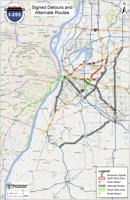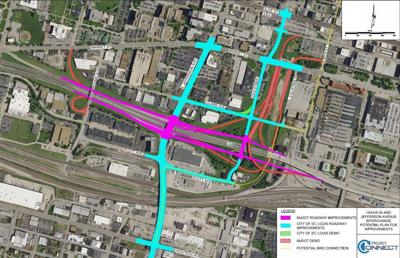ST. LOUIS — Tens of thousands of motorists who regularly drive downtown could see their daily commute disrupted by major closures on both sides of the Mississippi River .
On Saturday, Illinois officials closed a 7-mile span of Interstate 255 in the Metro East for a $64 million rehab — affecting at least 50,000 vehicles that travel through the area each day.
And on Monday, five entrance and exit ramps on Highway 40 (Interstate 64) that carry nearly about 12,900 vehicles each weekday will close permanently to make way for improvements to Jefferson Avenue and construction of a Major League Soccer stadium near Union Station.
Officials on both sides of the river are asking motorists to take several designated detours.
People are also reading…
‚ÄúIt will take some time to get used to, but I‚Äôm sure it will smooth out pretty fast,‚Äù said John Parker, spokesman with the ◊Ó–¬–”∞…‘≠¥¥ Development Corporation. ‚ÄúIt will be a change ‚Äî it won‚Äôt be a difficult change ‚Äî but it will just be a change.‚Äù
In Illinois, both directions of I-255 will be shut down from Illinois Route 15 north to Old Collinsville Road until at least mid-June. Closing the entire stretch will shorten the overall timetable and make the project less expensive, said Paul Grabowski, supervising field engineer for the Illinois Department of Transportation, District 8.
“If we do it this way we get it all done in one season,” he said, adding that it also makes it a safer environment for construction workers and for motorists, who aren’t navigating a confusing construction zone.
IDOT suggests several alternate routes. A full map of the suggested detours is available at stltoday.com.
Meanwhile, the closure will add to the impact of the long-delayed reopening of the Martin Luther King Bridge into downtown ◊Ó–¬–”∞…‘≠¥¥. Joel Cumby of IDOT said the target date is midsummer.
“We understand the impact of having that bridge closed,” Cumby said. “We’re trying to take every measure we can to get the work done.”
I-64 ramp closings

This image shows planned changes to the street grid and ramps onto and off of Highway 40 (Interstate 64) in Downtown West around the site of a planned Major League Soccer stadium (image via city of ◊Ó–¬–”∞…‘≠¥¥, MoDOT).
Meanwhile, five major I-64 ramps to and from Pine, Market/Chestnut and Ewing streets will close by 10 a.m. Monday to allow for construction to begin on the city’s new soccer stadium district. The district, designated between 20th and 22nd streets just north of I-64, will feature a Major League Soccer stadium, which the team owners hope to open by March 2022, team headquarters and practice fields.
The closures Monday also speed up the timeline for previously planned construction to from westbound I-64 to 22nd Street and Jefferson in anticipation of construction of a National Geospatial-Intelligence Agency campus north of downtown.
The five I-64 ramps being closed are:
I-64 westbound:
• On-ramp from Pine Street and Market Street
• Exit 39 at Market Street
I-64 eastbound:
• On-ramp from South Ewing Avenue
• On-ramp from Pine Street and Market Street
• Exit 38B at North 20th Street and Chestnut Street
Altogether, the five ramps carried about 12,900 vehicles each weekday, according to the Missouri Department of Transportation.
• I-64 east to Market carried 4,100 vehicles each weekday
• Pine onto westbound I-64 carried 2,700 vehicles each weekday
• Pine onto eastbound I-64 carried 1,500 vehicles each weekday
• I-64 west to Market carried 2,000 vehicles each weekday
• Ewing onto I-64 east – 2,600 vehicles each weekday.
◊Ó–¬–”∞…‘≠¥¥ officials are asking motorists who regularly used the ramps to take six detour routes:
• I-64 east to 14th Street
• I-64 east to Market Street
• 18th Street onto I-64 east toward Illinois
• Pine Street onto I-64 west
• I-64 west to Market and 21st
• Ewing Avenue to I-64 east toward Illinois
Detailed directions can be found at .
The ramps are remnants of a long-planned, controversial 3.3-mile North-South Distributor Highway meant to connect Interstate 70 to both interstates 44 and 55.
First proposed in the late 1940s, the highway plan died in the early 1980s following criticism from residents in north city neighborhoods who said it would force residents to relocate, decrease air quality and block efforts to renovate old structures and build new housing. Proponents said the highway would have relieved traffic congestion and boosted economic development.
A 1979 estimate put the cost of the highway at $85 to $136 million; the Missouri Department of Transportation estimated the work would require moving more than 2,000 people, destroying more than 500 homes, 67 businesses, three churches and two schools.
Amanda St. Amand and Beth O’Malley of the Post-Dispatch contributed to this report.









